#qixia temple
Explore tagged Tumblr posts
Text
Architecture (Part 24): Chinese Pagodas
The Chinese pagoda is a combination of two sources – 1) the multi-storied wooden tower, which developed before Buddhism arrived in the 00's BC, and forms the main body of the pagoda; and 2) the Buddhist stupa from India, which forms its spire or finial. Pagodas were usually made of wood or brick, or a combination of the two.
The base plan varied between different dynastic periods. Overall, though, the square plan was the main choice before the 900's AD, and then polygonal plans became dominant.
Pagoda style changed and evolved – because of the influence of new stupa forms in the West, stylistic evolution, and changes in faith. Pagodas were not only built on Buddhist sites: they could be on their own, and were occasionally used in feng shui interpretations.
The Songyue Pagoda was built in 523 AD, during the Northern Wei Dynasty (386-535). It is located in the Henan province, at the Songyue Monastery on Mount Song. It is the oldest-existing brick pagoda in China, and at the time of its construction, most pagodas were made of wood.
It is the only Chinese pagoda to have a 12-sided (dodecagonal) base plan. It is 40m high, and made of yellow brick & clay mortar. The height of the pagoda decreases towards the top.
The ground floor is very high (this is common in pagodas with multiple eaves). Balconies divide it into two sections. On the outside, the doors and niches are carved with teapots and lions. The pillars have lotus-flower carvings on the bases, and lotus-flower & pearl carvings on the capitals.
Above the ground floor, there are 15 stories, all closely-spaced and with their own individual roofs. These roofs are lined with eaves and small lattice windows. Each storey is ornamented with ornamented bracket-cluster eaves in the dougong style. The pagoda is topped with a mast and discs.
Inside, the pagoda is octagonal rather than dodecagonal. There are 8 levels of projecting stone supports, probably to support the original wooden floors. A series of burial chambers were built beneath the pagoda; the innermost chamber had Buddhist relics, statues and scriptures.

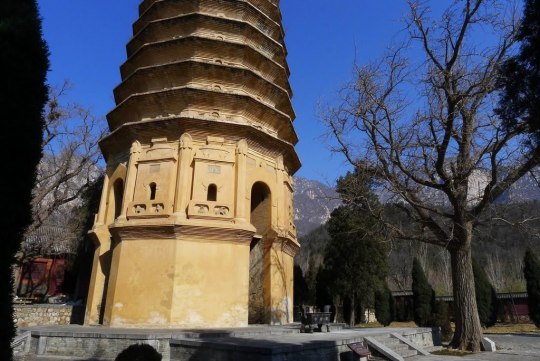
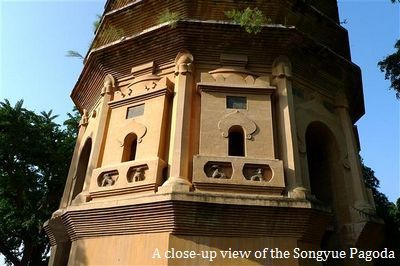
Sarira Pagoda (937-75) is located at the Qixia Temple in Nanjing. It is small, and made of white stone. The base plan is octagonal, and it has five stories.
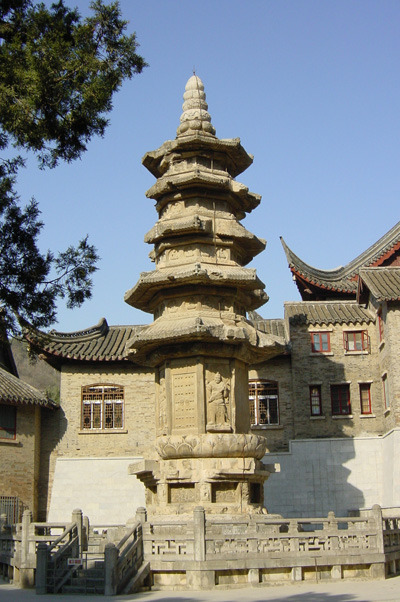
Sarira Pagoda.
Reliefs are carved on the exterior walls. On the base, there are various reliefs of the Buddha; also dragons, phoenixes, birds and flowers. On the body of the pagoda, there are carvings of the Heavenly Kings (four Buddhist gods who watch over the four cardinal points of the world), the Wenshu Buddha (Manjusri, the Buddha of Wisdom), and Puxian Buddha (Bodhisattva of Universal Benevolence) riding an elephant.
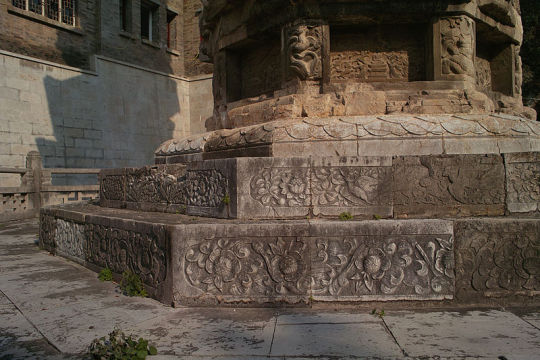
Base of the pagoda.
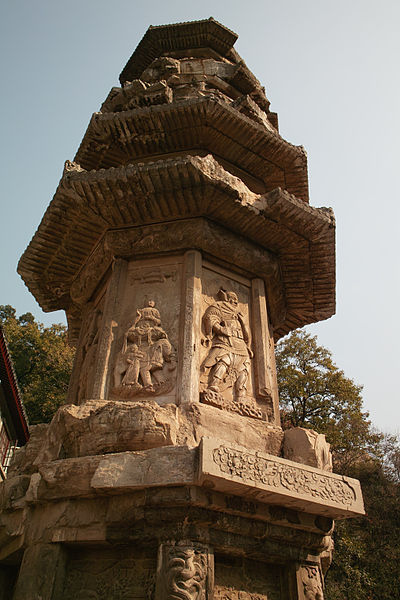
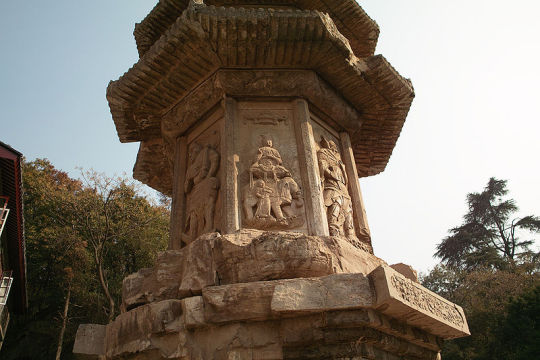
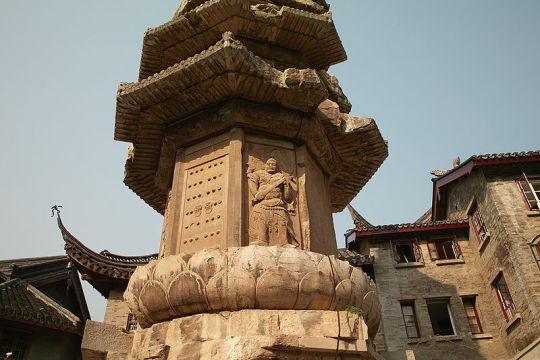
Carvings on the main body.
On each storey, there is a shrine with a Buddha. The base and finial are richly decorated with lotus motifs; the lotus is part of the imagery of the “Pure Land” school of Buddhism.
The Sakyamuni Pagoda was built in 1056, during the Liao Dynasty (907-1125), which ruled present-day Mongolia, part of the Russian Far East, northern Korea, and northern China. It was built by Emperor Daozong, who took the throne in 1055, and built on the site of his grandmother's family home. It is located on the central point of the Fogong Temple's main north-south axis (a common choice of location before the 700's).
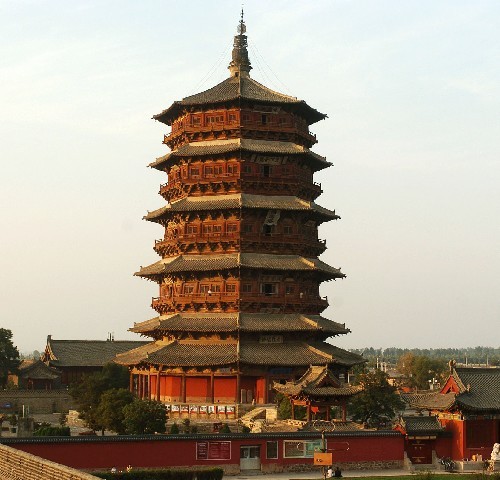

The temple was built 85km south of Datong (the Liao Dynasty capital) in Shanxi province. It was originally called Baogong Temple, and was renamed Fogong Temple in 1315, during the Yuan Dynasty. During the Jin Dynasty (1115-1234), its grounds were said to be massive, but it declined during the Ming Dynasty (1368-1644).

Liao Dynasty (1025).
The pagoda is the tallest wooden building in the whole of China, and is the oldest-existing pagoda to be built entirely of wood. It is 67.3m tall – it stands on a 4m-tall base, and the steeple is 10m tall.
It has 54 different types of bracket sets (the most for any Liao Dynasty building), but this isn't noticeable from a distance, as its structure has a high level of harmony and unity. There is a mezzanine level between each outer storey.
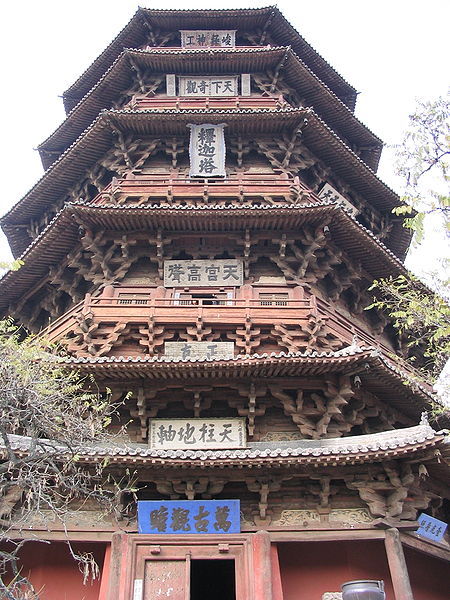
Dougong of the pagoda.
From the outside, the pagoda seems to have only 5 stories, and the ground floor seems to have two sets of rooftop eaves. Actually, there are 9 stories inside, as indicated by the pagoda's exterior pingzuo (terrace balconies). [I'm not sure if these are the same as the mezzanine levels.] The lower set of rooftop eaves on the ground floor covers the skirting verandah.
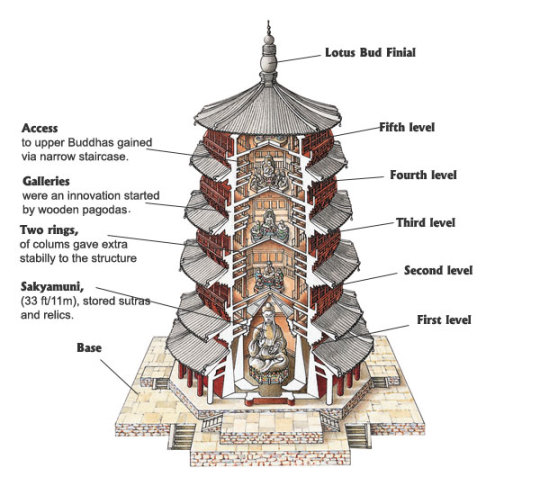
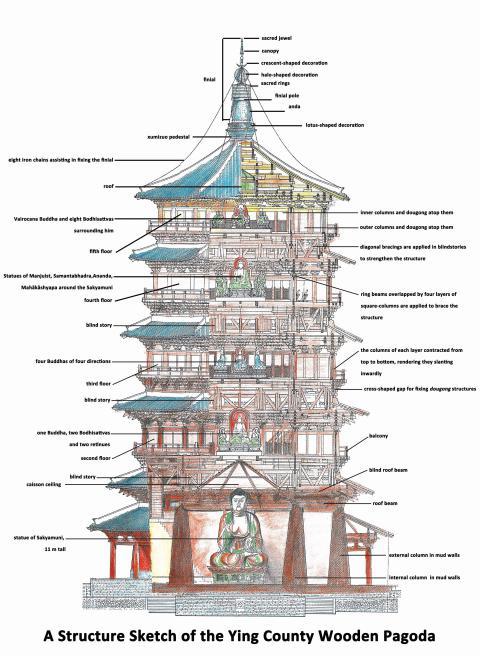
The lowest set of eaves is supported by a ring of columns; there are also support columns inside. The pagoda is named because of the 11m-high statue of the Buddha Sakayumi on the ground floor. There is an ornate zǎojǐng (cassion) above its head, and also one zǎojǐng carved into the ceiling of each storey. The pagoda has a hexagonal base plan, but is 8-sided.

Ground floor.
A zǎojǐng (meaning literally “algae well”) is also called a cassion, cassion ceiling, and spider web ceiling. It is a feature of East Asian architecture, found usually in the ceilings of temples & palaces, and usually in the centre, right above the main throne, seat or religious figure (here, it is the statue of the Buddha). Usually, it is a sunken panel set into the ceiling, often layered & richly decorated. Circles, squares, hexagons, octagons, and combinations of those shapes are common.

Cassion in the Forbidden City.
The Beisi Pagoda (also called the North Temple Pagoda) is located in the Bao'en Temple in Suzhou. The original pagoda was built in 1153, during the Song Dynasty (960-1279); the Buddhist monk Dayuan was in charge of its patronage and construction. The pagoda burned down near the end of the Song Dynasty, and was rebuilt during the Ming Dynasty (1368-1644). This is the pagoda that we have today.
It has an octagonal base, and is 76m tall. There used to be eleven stories, but it was damaged at some point and now there are only nine. It has double eaves and flying corners. The base and outside walls are made of brick, and the balustrades are made of stone. However, because it is wrapped with wooden cladding (the eaves and banisters are wooden), it looks like a timber structure from the outside.
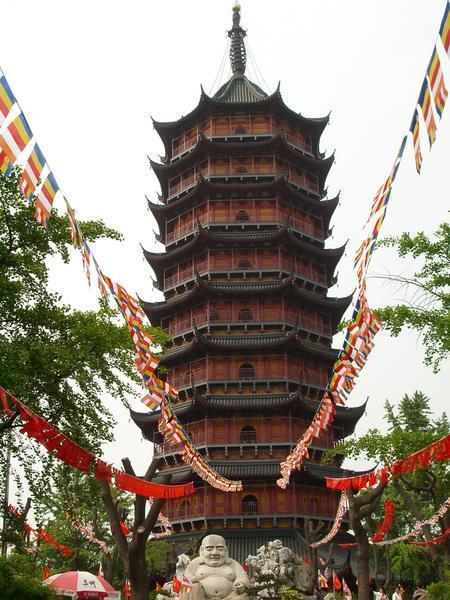
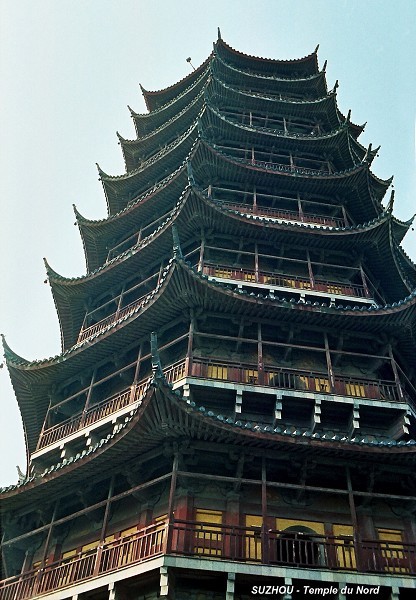
Kaiyuan Temple is located in Quanshou, in Fujian province (south-eastern China). Originally called Lotus Temple, it was built in 685-86, during the Tang Dynasty, and gained its present name in 738. It is a Hindu-Buddhist temple, and one of the few surviving Hindu temples in mainland China.
Two twin pagodas stand to either side of the temple, about 200m apart from each other; they are the highest twin pagodas in China. Renshou Pagoda is on the west side, and Zhenguo Pagoda on the east. They are octagonal plans, and their eave corners turn upwards dramatically, in typical southern style. Their elaborate bracket sets imitate woodwork.
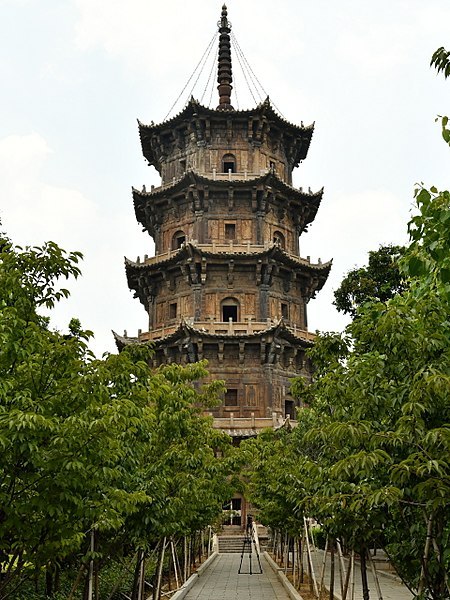
Renshou Pagoda.
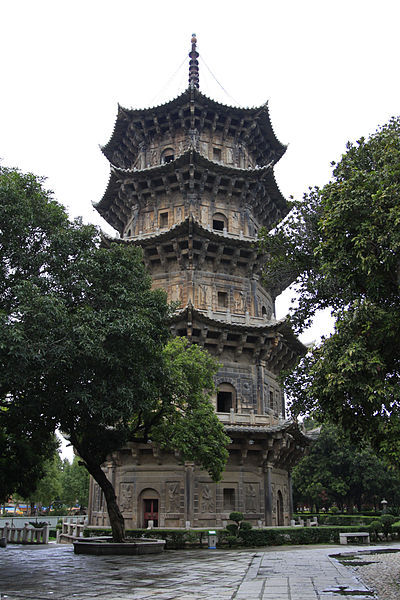
Zhenguo Pagoda.
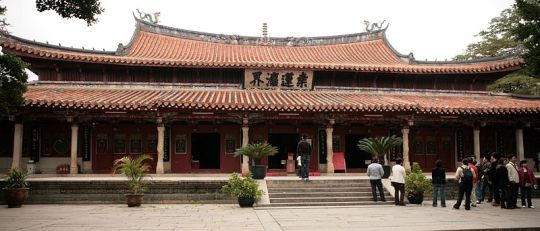
Mahavira Hall (the temple’s main hall).
The first Renshou Pagoda was built in 916, during the Five Dynasties period (907-60), and made of wood. It burned down twice in the Song Dynasty (960-1279), and was rebuilt each time – first with brick, and then with stone. Both pagodas have the same appearance and structure. Renshou Pagoda is 44.6m high, the shorter of the two.
Zhengou Pagoda was built during the Xiantong Period (860-73) of the Tang Dynasty (618-907). It was destroyed in 1155 and rebuilt in 1186; then demolished again in 1227 and rebuilt in stone in 1238. It is 48.24m high, 18.5m in diameter, and each side is 7.8m wide.
It stands on a Sumeru pedestal (a type of substructure named after the mythical Mount Sumeru). This Sumeru pedestal is quite low, and carved with a tier of lotus flowers and a tier of grasses. A celestial guard shouldering the pedestal is carved on each of its eight corners; and its girdle is carved with 39 pictures, including tales about the Buddha, and images of dragons, lions and other animals. The pedestal is surrounded by stone railings, and has five steps cut into each of its four sides.
Four of the pagoda's walls have doors, and the other four have niches for Buddhist statues. On both sides of the doors, images of heavenly kings and celestial guards are carved. On both sides of the niches, images of Manjusri, Samantabhadra & other bodhisattvas are carved, as well as gods and Buddhist disciples. Some carry the sun and moon in their palms; others hold calabashes or sceptres.
Each storey has a verandah on the outside. The corners of each storey are cylindrical, which is rare in ancient architecture.
Inside, there is a central pillar, winding corridors, and staircases. Unlike most winding or vertical staircases in pagodas, these aren't built along the inside of the walls, or along the central pillar. Instead, they are installed through a square hole on one side of the pillar (the pillar is solid and has no compartments). The floors are made up of two layers, with a facing of stone strips, and are supported by stone beams.
The iron steeples are stylistically typical of multi-storeyed pagodas. Iron chains connect them to the corners of their roofs.
The White Dagoba is located at Miaoying Temple, which is also called the White Stupa Temple or White Dagoba Temple. The temple was built in the city of Dadu, and is now in Beijing's Xicheng District. Dagoba is Sinhalese for the Buddhist stupa, and the word shows the building's Tibetan origins.
In 1271, Kublai Khan united the country of China under the Yuan Dynasty (1271-1368), and Tibet also began to come under the Yuan Dynasty's power. To consolidate the relationship between the empire and Tibet (which was mostly under the rule of religious authorities), Kublai Khan ordered the White Dagoba to be built. The architect was Anigo, from Nepal.
The construction lasted from 1271-79. Then, Kublai Khan ordered a temple to be built around it. The area of the temple was 160,000m2, and this was decided by the Emperor firing four arrows in four directions from the top of the White Dagoba. The temple was called Dashengshou Wan'an Temple.
During the Yuan Dynasty, the temple was mostly used as an imperial temple. The governor ordered that all important ceremonies were to be rehearsed here three days ahead of time. When Kublai Khan died, his sacrificial ceremony was held here.
People called Dadu (the capital at the time) and the White Dagoba “Golden City and Jade Dagoba”. The temple was burned down in 1368, but the dagoba survived. In 1457, during the Ming Dynasty (1368-1644), Emperor Tianshun ordered the temple to be rebuilt. However, it was much smaller this time – about 13,000m2 – and it was renamed Miaoying Temple.
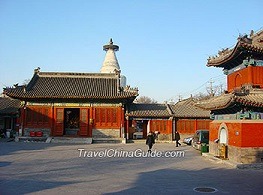
The current temple.
In the late Qing Dynasty (1644-1911), the Miaoying Temple was one of the most well-known locations for temple fairs, hence the saying, “August 8th, time to visit the white dagoba”. On October 25th (according to the lunar calendar), there was a custom of lamas walking around the dagoba, chanting scriptures and playing music. This is the anniversary of the dagoba's completion.
The Miaoying Temple consists mostly of the White Dagoba and four halls (which store Buddhist statues, classical Buddhist scriptures, five Buddhist crowns, flowery cassocks, fabrics, and other artifacts). The golden Dagoba Longevity Statue is the most famous – it is 5.4cm tall, and has over 40 rubies. The bronzy [?] Kwan-yin Boddhisattva Statue (with 1000 hands & eyes) is also very famous. These current halls are from the Qing Dynasty.
The White Dagoba is north of the Miaoying Temple. It has a 3-layered base, and the body looks like an upside-down ice-cream cone. On top of the body is a thick wooden base, upon which is a solid bronze canopy. This is supported by strong iron chains. On the very top is another small stupa.
It is made of white-washed brick, and is 48m tall. The borders of the dagoba [or the stupa on top?] are adorned with small Buddhist characters and statues, and wind chimes. This dagoba is the earliest and largest Tibetan dagoba in China.

The White Dagoba.
#book: a concise history of architectural styles#history#architecture#china#ancient china#tibet#chinese architecture#chinese pagodas#northern wei dynasty#liao dynasty#yuan dynasty#song dynasty#ming dynasty#tang dynasty#qing dynasty#quanshou#songyue pagoda#songyue monastery#sarira pagoda#qixia temple#sakyamuni pagoda#fogong temple#beisi pagoda#bao'en temple#kaiyuan temple#renshou pagoda#zhenguo pagoda#white dagoba#miaoying temple
34 notes
·
View notes
Photo

The Five Hundred Arhats, Wu Bin, 1591-1626, Cleveland Museum of Art: Chinese Art
Disciples of the Buddha with supernatural powers, arhats (also called lohans) populate this scroll. Far advanced on the path to enlightenment, they have not yet reached full Buddhahood. Traditionally depicted with foreign features, they have the capacity to tame tigers, free dragons, and to float on water or in the air. Originally from Fujian province, the artist Wu Bin moved to Nanjing by 1600 where he was affiliated as a Buddhist layman with the Qixia temple. He specialized in landscapes and Buddhist subjects. The gnarled and grotesque figures delineated in brush lines without shading, combined with light pastel colors, reveal Wu Bin’s originality and inventiveness. More than 66 feet long and probably the most complex of the artist’s figural compositions, this scroll depicts 500 arhats, 18 attendants, and Guanyin, the bodhisattva of compassion, at its very end. The result is an engaging and amusing assortment of characters. Size: Overall: 39.5 x 2646.5 cm (15 9/16 x 1041 15/16 in.); Painting only: 37.7 x 2347 cm (14 13/16 x 924 in.) Medium: handscroll, ink and color on paper
https://clevelandart.org/art/1971.16
6 notes
·
View notes
Text
300+ TOP GENERAL AWARENESS Objective Questions and Answers
GENERAL AWARENESS Multiple Choice Questions :-
1. .......... Temple is a Buddhist temple located in Nanjing, Jiangsu province in China. A) Alxxca B) Qixia C) Qixxia D) Alxca 2. ............ set up the Mahatma Gandhi Sewa Ashram to rehabilitate dacoits and was awarded the Rajiv Gandhi National Sadbhavana Award in 2003. A) Saatvik Baba B) Ram Shankar C) K K Jaitely D) S. N. Subba Rao 3. The Saraswati Samman award for 2012 was given to ...... A) Manoj Das B) Sunil Gangopadhyay C) Rohit Gautam D) None of Above 4. .......... was the 10th President of South Korea. A) Lee Myung-bak B) Roh Moo-hyun C) Oh Se-hoon D) Yoon Jeung-hyun 5. Dadasaheb Phalke award for year 2011 was given to ............... A) Dilip Kumar B) Kishore Kumar C) V. K. Murthy D) Soumitra Chatterjee 6. The professional body representing horticulturists in Great Britain and Ireland is the Institute of Horticulture (IOH). A) True B) False 7. The first ULIP was launched in India in ............ A) 1978 by ULIP Trust B) 1969 by SBI C) 1971 by Unit Trust of India D) 1981 by ICICI Bank 8. The Saraswati Samman for outstanding prose or poetry literary works in any Indian language was instituted in 1991 by the ........ A) Radha Swamy Foundation B) Tata Group Foundation C) Govt. Of India D) K. K. Birla Foundation 9. Digital Subscriber Loop is a technology that provides Internet access by transmitting digital data over the wires of a local telephone network. A) True B) False 10. Which of the following is an horticulture crop in India? A) cabbage B) brinjal C) onion D) tomato

GENERAL AWARENESS MCQs 1. .............. was the first state to ban Burqa in public places. a) Belgium b) London c) Illinois d) Kerala 2. Market Economy Status was given to Vietnam by ............ a) US b) USSR c) Japan d) India 3. Special drawing rights (SDR) is also known as A) Paper Platinum B) Paper Gold C) FDR D) CKY 4. A hard drive is non-volatile storage. a) True b) False 5. Libya's Airbus jet crashed when it tried to land in Tripoli, killing 103 people on board, most of them dutch. An 8-year-old Dutch boy was the sole survivor. a) True b) False 6. ............. refers to a low power mode for electronic devices such as computers, televisions, and remote controlled devices. a) Hibernation b) Power down c) Sleep mode d) Non-Awk mode 7. An additional interest rate is given on retail domestic term deposits of .......... A) Women B) SC / ST C) Farmers D) Senior citizens 8. The first SAARC summit was held in ......, Bangladesh on 7–8 December 1985. a) Dhaka b) Assam c) Nepal d) Sri Lanka 9. ............. (born April 27, 1937) was a former Union Minister and Karnataka's Congress President. a) Jail Singh b) Prabhu Vicky c) Keshav Tiwari d) Janardhan Poojari 10. SEPA stand for ................... a) Super Electronic Purchase Agency b) Single Euro Payments Area c) Single Electronic Processing Agency d) Single Exchange Processing Agency e) None of these Answers 1) a, 2) d, 3) b, 4) a, 5) a, 6) c, 7) d, 8) a, 9) d, 10) b 1. In monopolistic conditions, marketing and selling are very important in order to earn higher profits. A) True B) False 2. Market .............. is dividing the market into groups of individual markets with similar wants or needs that a company divides into distinct groups which have distinct needs, wants, behavior. A) Fragmentation B) Sub-Division C) Segmenting D) Sub- Strategy 3. The ..................... Dam is a gravity dam currently under construction on the Brahmaputra River in the Tibet Autonomous Region of China. A) Zangdmu B) Zangmnu C) Zangmu D) Zandmu 4. ............... were the first formal institutions established to provide credit to rural India A) Rural Cooperative Banks B) Rural Banks C) Development Banks D) Regional Banks 5. The Nationalist Socialist Council of Nagaland (NSCN) is a Naga nationalist extremist group operating in Northeast India. The main aim of the organization is to establish a sovereign state ............... A) Nagalin B) Nagal C) Nagalim D) Naga 6. On April 23, ..................... was arrested on corruption charges of Rs 2 crore to recognise a college in Punjab. A) Dr. Amit Kumar B) Dr. Katan Desai C) Dr. S. D. Chaudhary D) Dr. K. T. Talwar 7. The practice of building ties to customers based on a salesperson's attention and commitment to customer needs over time is A) Selling to Relatives B) Tele Selling C) Knowledge Selling D) Relationship Selling 8. ........................................ acquired 26 percent stake of Krishna Godavari basin of deep sea block of Oil and Natural Gas Corporation (ONGC) in November 2012. a) Zenzo Exploration b) Cosmo Company c) Inpex Corp d) Maruzen 9. Odisha slapped a fine of .................. on Tata Steel for illegal mining in the month of November 2012? A) 6000 crore rupees B) 5000 crore rupees C) 4000 crore rupees D) 3000 crore rupees 10. ........................ recently tied up with ICICI Bank for launching its Mobile Payment Services. a) Airtel b) Idea c) Vodafone d) Aircel Answers 1) b, 2) c, 3) c, 4) a, 5) c, 6) b, 7) d, 8) c, 9) a, 10) c 1. Nokia's mobile map services in the Indian market is known as ............ a) NMaps b) NokiaMAPS c) DIRECT d) HERE 2. ............. operates in 20 countries across South Asia, Africa and the Channel Islands. In 2010, it acquired the African operations of the Kuwait based Zain Telecom. A) Vodafone B) Bharti Airtel C) Aircel D) Virgin 3. Penguin Books has tied up ................. for release of its books at the latter's selected cafes across the country. A) Café Coffee Day B) Hot Millions Coffee C) Barista Lavazza D) None of Above 4 ................... become the Chief Minister of a State in India third time consecutively. a) Vishwanath Pratap Singh b) Mamta Banerjee c) J. Jayalalitha d) Nitish Kumar 5 ................. was an Indian independence activist and political leader, remembered especially for leading the opposition to Indira Gandhi in the 1970s. The airport of Patna is also named after him. A) Devraj Pandhi B) Saran Kumar C) Jayaprakash Narayan D) M K Gandhi 6 ................. got Man Booker International Prize in 2011. A) Philip Roth B) Herman Roth C) Lucy Nelson D) Linda Samuel 7. NEFT means A) National Emblem and Fund Token B) Negotiated Easy Fund Transfer C) National Econimic Fund Transfer D) National Electronic Funds Transfer 8. ............. remained under the President's rule under President Pranab Mukherjee from 18 Janruary,2013. A) West Bengal B) Karnataka C) Jharkhand D) Orissa 9. During the April-June 2010 period, Personal computer sales in India touched ________units. a) 2.69 million b) 2.37 million c) 4.76 million d) 3.25 million 10. Which of the following is / was not an Airline in India A) Club One B) Air India Regional C) GoAir D) Club All Answers 1) d, 2) b, 3) c, 4) d, 5) c, 6) a, 7) d, 8) c, 9) b, 10) d 1. On 1 November 1956, the state of Kerala was formed by the States Reorganisation Act merging the Malabar district, The state of kerala was formed on ......... A) 1 November 1956 B) 1 November 1966 C) 1 November 1952 D) 1 November 1949 2. Banda Singh Bahadur (1670���1716), a military commander, was also known by the name of A) Hira Lal B) Hira Gupta C) Laxman Das Bhardwaj D) Laxman Das Gupta 3. Which of the following city is not in Punjab. A) Amritsar B) Ambala C) Jalandhar D) Ludhiana 4. ............. also categorized as a wetland, is the largest fresh water lake in Kerala, A) Jheluman B) Punnamadda C) Munroethuruth D) Sasathamkotta Lake 5. Godavari river originates near Trimbak in Nashik District of Maharashtra state. A) True B) False 6. In the 2009 general elections, the Congress party emerged as the single largest party (in the Lok Sabha) with .......... of its candidates getting elected to the 543-member house. A) 204 B) 205 C) 206 D) 207 7. A Union Territory, unlike the states of India, which have their own elected governments, are ruled directly by the ..................... A) President of India B) Central govenrnment C) State government D) Federal government 8. Shri Dharma Sastha temple is a Hindu temple located in ......., India. A) Tamil Nadu B) Kerala C) Port Blair D) Calcutta 9. The law created by a legislature is called ................. A) Common law B) Statutory law C) Civil law D) Socialist law 10. In 1966, during Indian states reorganization, the Lakshadweep islands were organized into a separate union territory for administrative purposes. A) True B) False Answers 1) a, 2) c, 3) b, 4) d, 5) a, 6) c, 7) , 8) b, 9) b, 10) b 1. Slogan of "Jai Jawan Jai Kisan" ("Hail the soldier, Hail the farmer") was given by ...... A) Lal Bahadur Shastri B) Mahatma Gandhi C) Jawahar Lal Nehru D) Lala Lajpat 2. The India Today (an Indian English language weekly magazine) was established in ........., by VV Purie owner of Thompson Press. A) 1973 B) 1974 C) 1975 D) 1976 3. Indira Gandhi was the .......... Prime Minister of India. A) Sixth B) Fifth C) Fourth D) Third 4. S. H. Kapadia was sworn in as the Chief Justice of India by the President Pratibha Patil on .......... A) 29 Sep 2012 B) 12 May 2010 C) 12 May 2009 D) 29 Sep 2011 5. Newspaper "The Hindu" was founded in Madras on ................. as a weekly by four law students. A) 23 September 1878 B) 22 September 1878 C) 21 September 1878 D) 20 September 1878 6. The 2008 Mumbai attacks ........... was the only attacker who was captured alive. A) Umar Muhammad B) Ajmal Kasab C) David Headley D) Agmal Kasab 7. Manmohan Singh is the only Prime Minister since Jawaharlal Nehru to return to power after completing a full five-year term. A) True B) False 8. ............. is one of the architects of the Rs 1 per kg rice scheme announced by the Kiran Kumar Reddy government recently, in Andhra Pradesh. A) Kumar Manaalam B) NK Tripathi C) Chandrababu Naidu D) Sridhar Babu 9. In contrast with a state's Vidhan Sabha (Legislative Assembly), the Legislative Council is a permanent body and can be dissolved. A) True B) False 10. .........., a senior congress MLA, won as MLA in the last 2009 general elections in a tough contest by defeating his once aide turned rival Putta Madhu of the erstwhile Praja Rajyam Party (PRP) by a margin of over 13000 votes. A) T K Patil B) Sridhar Babu C) Sri Ram Gupta D) T N Sharma Answers 1) a, 2) c, 3) d, 4) b, 5) d, 6) b, 7) a, 8) d, 9) b, 10) b 1. In August 1982, Bhindranwale and the .......... launched the Dharam Yudh Morcha. A) Congress B) Akali Dal C) BJP D) SJP 2. Panipat Refinery is an oil refinery located in ...... village, Panipat, India. A) Bhadai B) Majra C) Jind D) Baholi 3. President's Rule was imposed in Jharkhand (a state in eastern India) on ......, 2013. A) January 18 B) January 19 C) January 20 D) January 21 4. Jamshedpur is the first planned industrial city of India, founded by the late ........... It is also known as Steel City or TataNagar. A) Jamshedji Wasabi B) Jamshedji Jhunjhunwala C) Jamshedji Nusserwanj D) Jamshedji Narrerwanj 5. ................ was conferred with Arjuna Award, India's second highest sporting award in the year 2012 by President of India Pranab Mukherjee. A) Deepika Kumari B) Deepika Popat C) Deepika Sahai D) Deepika Ghai 6. Indian Oil Corporation Limited, or IndianOil, is an Indian ........ oil and gas corporation with its headquarters in New Delhi. A) center-owned B) state-owned C) Public-owned D) Private-owned 7. Haryana state in India was formed on .............. A) 1 November 1965 B) 1 November 1966 C) 1 November 1967 D) 1 November 1968 8. PSU companies are divided into three categories: Maharatna, Navratna, Miniratna CPSEs. A) True B) False 9. .............. first novel A Case of Exploding Mangoes was shortlisted for the 2008's Guardian First Book Award and also longlisted for the 2008 Man Booker Prize. A) Salman Rushdie B) Mohammed Khalid C) Meera Nair D) Mohammed Hanifs 10. Pranab Kumar Mukherjee is the ......... President of India, in office since July 2012. A) 11th B) 12th C) 13th D) 14th Answers 1) b, 2) d, 3) a, 4) c, 5) a, 6) b, 7) b, 8) a, 9) d, 10) c 1. Former name of Grand Trunk Road was ....... A) UttaraPatha B) Shah Rah-e-Azam C) Sadak-e-Azam D) Badshahi Sadak E) All of Above 2. National Bank for Agriculture and Rural Development (NABARD) is an apex development bank in India having headquarters based in ........... A) New Delhi B) Mumbai C) Hyderabad D) Bangalore 3. The RBI is not a member bank of the Asian Clearing Union. A) True B) False 4. Notable coal-mining areas in India include: A) Andhra Pradesh B) Maharashtra C) Haryana D) Jharkhand 5. ................ is the 22nd and current Governor of Reserve Bank of India, serving under Prime Minister Manmohan Singh. A) S. Jagannathan B) M. M iyer C) Duvvuri Subbarao D) None of Above 6. ............was the second Chief Minister of West Bengal in India A) Bidhan Chandra Roy B) Buddhadeb Bhattacharya C) Jyoti Basu D) Mamata Banerjee 7. The concept of IITs was first introduced in a report in the year 1945 by ............., then member of Education on Vicerory's Executive Council. A) Sh. R. M. Sharma B) Sh. K. K. Boparai C) Sh. P. C. Nanda D) Sh. N. M. Sircar 8. Nabha was founded by the great-grandson of Phul in ....... A) 1753 B) 1754 C) 1755 D) 1756 9. ........... is an Indian self-taught artist, famous for building the Rock Garden of Chandigarh. A) Nek Chand Sharma B) Nek Chand Saini C) Nek Chand Sundar D) Nek Chand Kundra 10. Bombay Stock Exchange, commonly referred to as the BSE is a stock exchange located on Dalal Street, Mumbai, India. It is the ....... largest stock exchange in the world by market capitalization. A) 10th B) 11th C) 12th D) 13th Answers 1) e, 2) b, 3) b, 4) a,b,d, 5) c, 6) a, 7) d, 8) c, 9) b, 10) a 1. Which of the follwoing is the Sarala Puraskar awardee: A) Hrusikesh Dhall B) Hrusikesh Gupta C) Hrusikesh Panda D) Hrusikesh Sharma 2. The longest women's tennis match (by time) took place at a tournament in ........... in 1984, when Vicki Nelson took 6 hours, 31 minutes to defeat Jean Hepner 6–4, 7–6(11–9). A) Seattle B) Richmond C) Las Vegas D) San Diego 3. ......... is a third generation "Fire-and-forget" anti-tank missile developed in India by the Defence Research and Development Organisation. A) Nagesh B) Nag C) Aag D) Nishana 4. .......... is a Hindu folk–deity of Rajasthan in India. He was a Rajput ruler of the fourteenth century, said to have miraculous powers who devoted his life for the upliftment of poor people of the society, and revivalism of Hinduism (which were marginalized by invaders). A) Ramdeo Pir B) Krishna C) iyer Guru D) Raja Jadeja 5. .......... is a city and a municipality located in Jaisalmer district in the India. It served as the test site for India's first underground nuclear weapon detonation. A) Ramsinghpur B) Mundawar C) Hamirgarh D) Pokhran 6. Indira Awaas Yojana (1985) was related to A) Housing for the rural poor B) Rice for the rural poor C) Wheat for the rural poor D) Farming for the rural poor 7. The postal service is under the ................, which is part of the Ministry of Communications and Information Technology of the Government of India. A) Department of Communication B) Department of Affairs C) Department of Posts D) Department of Service 8. ........................... would give an opportunity to the income tax/ wealth tax defaulters to disclose their undisclosed income at the prevailing tax rates. This scheme was launched on June 18, 1997 A) VDIS B) VVS C) VRS D) VRIS 9. The ................. of India is an authority, established by the Constitution of India under Chapter V, who audits all receipts and expenditure of the Government of India and the state governments. A) CAG B) CCG C) CDG D) CDD 10. Who among the following was chief 'justice of India and was also the sixth Vice-President of India. A) Raja Ram Kumar B) V. V Giri C) Mohammad Hidayatullah D) C.K Pradhan Answers 1) c, 2) b, 3) b, 4) a, 5) d, 6) a, 7) c, 8) a, 9) a, 10) c 1. The current CAG of India is .........., who was appointed on 21 May 2013. He is the 12th CAG of India. A) Shashi Kumari Bhallla B) Jyoti Mishra C) Shashi Kant Sharma D) R. N. Sharma 2. A ......... is a written document prepared by police organizations in Bangladesh, India, Pakistan and Japan when they receive information about the commission of a cognizable offence. A) CGR B) FIR C) TTR D) MKR 3. The ............... is an agency within the United States Department of State charged with investigating and creating programs to prevent human trafficking both within the United States and internationally. A) Office to JMP and Combat Trafficking in Persons (J/TIP) B) Office to Joepardy and Combat Trafficking in Persons (J/TIP) C) Office to Joint and Combat Trafficking in Persons (J/TIP) D) Office to Monitor and Combat Trafficking in Persons (J/TIP) 4. Sunil Gavaskar held the record of 34 Test centuries for almost two decades before it was broken by .......... in December 2005. A) Rahul Dravid B) M. S Dhoni C) Sachin Tendulkar D) Yuvraj Singh 5. The highest post office in the world is in .......... Himachal Pradesh, India at a height of 15,500 ft. A) Rohtang Pas B) Manali C) Shimla D) Hikkim 6. ............... The largest cricket stadium in India and second-largest in the world by seating capacity, it is widely acknowledged to be the most iconic cricket stadium in India. ...... has been called "cricket's answer to the Colosseum". A) Eden Gardens B) Feroz Shah Kotla C) Wankhede Stadium D) JSCA International Cricket Stadium 7. .............. is a cricket franchise representing Kolkata in the Indian Premier League and owned by Bollywood actor Shah Rukh Khan's company Red Chillies Entertainment in partnership. A) Chennai Super Kings B) Kolkata Knight Riders C) Mumbai Indians D) Rajasthan Royals 8. ............ was the Parliamentary Affairs Minister of India in the government of Prime Minister Manmohan Singh until October 27, 2005, when he was appointed as the Chief Minister of Jammu and Kashmir. A) Farooq Abdullah B) Sheikh Abdullah C) Ghulam Nabi Azad D) None of Above 9. The ........................ Party is a state political party in Jammu and Kashmir (founded in 1999) by the former Union Home Minister, Mufti Mohammed Sayeed. A) National Conference B) Indian National Congress C) Jammu and Kashmir National Conference D) Jammu and Kashmir People's Democratic 10. The Vice President of India is the second-highest office in India, after the President. A) True B) False Answers 1) c, 2) b, 3) d, 4) c, 5) d, 6) a, 7) b, 8) c, 9) d, 10) a GENERAL AWARENESS Questions and Answers pdf Download Read the full article
0 notes
Photo
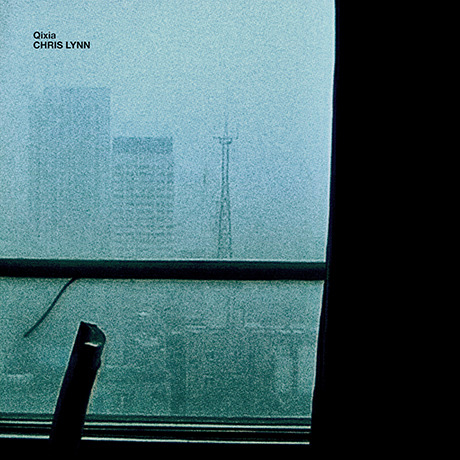
Chris Lynn
Qixia
digital release (flax/mp3)
Impulsive Habitat IH127
2017
How do people breathe in Qixia? If I open my mouth to yawn in Qixia, how much sound do I inhale? Straight away we’re dropped into the spongy humidity of “Nanjing Railway Station at Night”. Echoes, engines, exhaust fans, and even the familiar squeal of brakes get ensnared in a great gray fog, carried away as quickly as it came by the barbarian clod of an oncoming train. The train, too, seems more like a mirage—it is practically upon us, and then is merely a shimmering hiss. These shifts in activity and density (active/headyàimposingàsparse/faintàtonalàetc) keep me engaged but apart. Either I’m departing or this station is. Or both. People can be transient, just like spaces. But can people be transient spaces? In a way, Qixia feels more concerned with what it is to be passed through than what it is to be somewhere. I hear a “Soft Shower”—where? On what? It seems to be coming from inside my head; or when I hear my partner grind her teeth in her sleep; like it’s raining inside a very small room. Everything is translucent and permeable, but no more recognizable. Even the birds seem artificial; their songs erupting like pedestrian traffic signals. Thousands of insects get caught in eddies of distant, powerful weather. Or is it the hum of the city? Cicadas or power lines? Lynn’s work obfuscates the artificial and the organic. It’s an effect that is at once nerve-wracking and incredibly familiar. I do feel with absolute certainty that Lynn has really listened to these places. Even the tracks that initially feel like simple illustrations turn out to be incredibly detailed. The richness of sound in “Empty Boat on Xuanwu Lake,” as it bobs and gulps in the waves, is totally hypnotic. In someone else’s hands it might simply be charming or pastoral. Even the fucking rain is interesting. The final track, recorded in Qixia Temple, moves toward and away from us like a wick of flame, but the percussion seems as fixed as the sun, and always right there.
Highly recommended!
2 notes
·
View notes
Photo
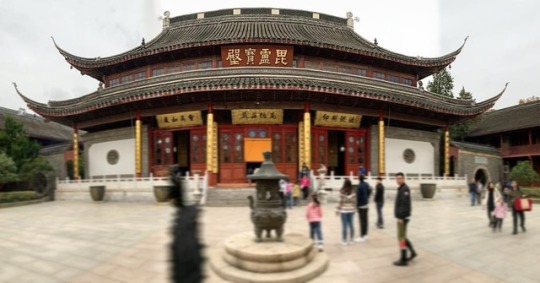
毗卢宝殿全景(在 Qixia Temple) https://www.instagram.com/p/BqZRPKEH3Qi/?utm_source=ig_tumblr_share&igshid=95z4m4nzl1uw
0 notes
Photo
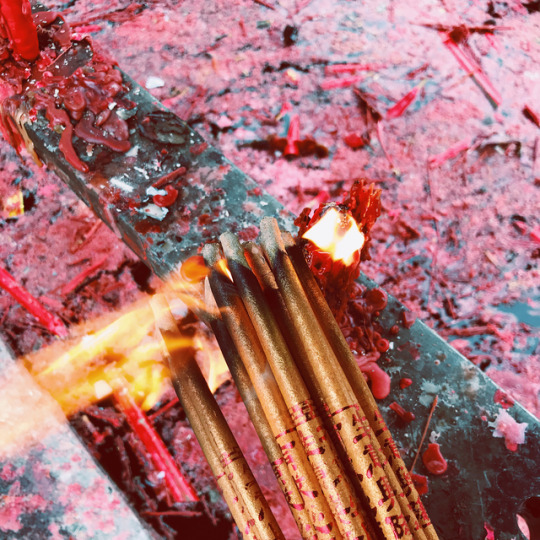
📿everything will be better🙌🏻 #photooftheday (at Qixia Temple)
0 notes
Photo

The Five Hundred Arhats, Wu Bin, 1591-1626, Cleveland Museum of Art: Chinese Art
Disciples of the Buddha with supernatural powers, arhats (also called lohans) populate this scroll. Far advanced on the path to enlightenment, they have not yet reached full Buddhahood. Traditionally depicted with foreign features, they have the capacity to tame tigers, free dragons, and to float on water or in the air. Originally from Fujian province, the artist Wu Bin moved to Nanjing by 1600 where he was affiliated as a Buddhist layman with the Qixia temple. He specialized in landscapes and Buddhist subjects. The gnarled and grotesque figures delineated in brush lines without shading, combined with light pastel colors, reveal Wu Bin’s originality and inventiveness. More than 66 feet long and probably the most complex of the artist’s figural compositions, this scroll depicts 500 arhats, 18 attendants, and Guanyin, the bodhisattva of compassion, at its very end. The result is an engaging and amusing assortment of characters. Size: Overall: 39.5 x 2646.5 cm (15 9/16 x 1041 15/16 in.); Painting only: 37.7 x 2347 cm (14 13/16 x 924 in.) Medium: handscroll, ink and color on paper
https://clevelandart.org/art/1971.16
4 notes
·
View notes
Photo

The Five Hundred Arhats, Wu Bin, 1591-1626, Cleveland Museum of Art: Chinese Art
Disciples of the Buddha with supernatural powers, arhats (also called lohans) populate this scroll. Far advanced on the path to enlightenment, they have not yet reached full Buddhahood. Traditionally depicted with foreign features, they have the capacity to tame tigers, free dragons, and to float on water or in the air. Originally from Fujian province, the artist Wu Bin moved to Nanjing by 1600 where he was affiliated as a Buddhist layman with the Qixia temple. He specialized in landscapes and Buddhist subjects. The gnarled and grotesque figures delineated in brush lines without shading, combined with light pastel colors, reveal Wu Bin’s originality and inventiveness. More than 66 feet long and probably the most complex of the artist’s figural compositions, this scroll depicts 500 arhats, 18 attendants, and Guanyin, the bodhisattva of compassion, at its very end. The result is an engaging and amusing assortment of characters. Size: Overall: 39.5 x 2646.5 cm (15 9/16 x 1041 15/16 in.); Painting only: 37.7 x 2347 cm (14 13/16 x 924 in.) Medium: handscroll, ink and color on paper
https://clevelandart.org/art/1971.16
4 notes
·
View notes
Photo

The Five Hundred Arhats, Wu Bin, 1591-1626, Cleveland Museum of Art: Chinese Art
Disciples of the Buddha with supernatural powers, arhats (also called lohans) populate this scroll. Far advanced on the path to enlightenment, they have not yet reached full Buddhahood. Traditionally depicted with foreign features, they have the capacity to tame tigers, free dragons, and to float on water or in the air. Originally from Fujian province, the artist Wu Bin moved to Nanjing by 1600 where he was affiliated as a Buddhist layman with the Qixia temple. He specialized in landscapes and Buddhist subjects. The gnarled and grotesque figures delineated in brush lines without shading, combined with light pastel colors, reveal Wu Bin’s originality and inventiveness. More than 66 feet long and probably the most complex of the artist’s figural compositions, this scroll depicts 500 arhats, 18 attendants, and Guanyin, the bodhisattva of compassion, at its very end. The result is an engaging and amusing assortment of characters. Size: Overall: 39.5 x 2646.5 cm (15 9/16 x 1041 15/16 in.); Painting only: 37.7 x 2347 cm (14 13/16 x 924 in.) Medium: handscroll, ink and color on paper
https://clevelandart.org/art/1971.16
2 notes
·
View notes
Photo

The Five Hundred Arhats, Wu Bin, 1591-1626, Cleveland Museum of Art: Chinese Art
Disciples of the Buddha with supernatural powers, arhats (also called lohans) populate this scroll. Far advanced on the path to enlightenment, they have not yet reached full Buddhahood. Traditionally depicted with foreign features, they have the capacity to tame tigers, free dragons, and to float on water or in the air. Originally from Fujian province, the artist Wu Bin moved to Nanjing by 1600 where he was affiliated as a Buddhist layman with the Qixia temple. He specialized in landscapes and Buddhist subjects. The gnarled and grotesque figures delineated in brush lines without shading, combined with light pastel colors, reveal Wu Bin’s originality and inventiveness. More than 66 feet long and probably the most complex of the artist’s figural compositions, this scroll depicts 500 arhats, 18 attendants, and Guanyin, the bodhisattva of compassion, at its very end. The result is an engaging and amusing assortment of characters. Size: Overall: 39.5 x 2646.5 cm (15 9/16 x 1041 15/16 in.); Painting only: 37.7 x 2347 cm (14 13/16 x 924 in.) Medium: handscroll, ink and color on paper
https://clevelandart.org/art/1971.16
5 notes
·
View notes
Photo

The Five Hundred Arhats, Wu Bin, 1591-1626, Cleveland Museum of Art: Chinese Art
Disciples of the Buddha with supernatural powers, arhats (also called lohans) populate this scroll. Far advanced on the path to enlightenment, they have not yet reached full Buddhahood. Traditionally depicted with foreign features, they have the capacity to tame tigers, free dragons, and to float on water or in the air. Originally from Fujian province, the artist Wu Bin moved to Nanjing by 1600 where he was affiliated as a Buddhist layman with the Qixia temple. He specialized in landscapes and Buddhist subjects. The gnarled and grotesque figures delineated in brush lines without shading, combined with light pastel colors, reveal Wu Bin’s originality and inventiveness. More than 66 feet long and probably the most complex of the artist’s figural compositions, this scroll depicts 500 arhats, 18 attendants, and Guanyin, the bodhisattva of compassion, at its very end. The result is an engaging and amusing assortment of characters. Size: Overall: 39.5 x 2646.5 cm (15 9/16 x 1041 15/16 in.); Painting only: 37.7 x 2347 cm (14 13/16 x 924 in.) Medium: handscroll, ink and color on paper
https://clevelandart.org/art/1971.16
8 notes
·
View notes
Photo

The Five Hundred Arhats, Wu Bin, 1591-1626, Cleveland Museum of Art: Chinese Art
Disciples of the Buddha with supernatural powers, arhats (also called lohans) populate this scroll. Far advanced on the path to enlightenment, they have not yet reached full Buddhahood. Traditionally depicted with foreign features, they have the capacity to tame tigers, free dragons, and to float on water or in the air. Originally from Fujian province, the artist Wu Bin moved to Nanjing by 1600 where he was affiliated as a Buddhist layman with the Qixia temple. He specialized in landscapes and Buddhist subjects. The gnarled and grotesque figures delineated in brush lines without shading, combined with light pastel colors, reveal Wu Bin’s originality and inventiveness. More than 66 feet long and probably the most complex of the artist’s figural compositions, this scroll depicts 500 arhats, 18 attendants, and Guanyin, the bodhisattva of compassion, at its very end. The result is an engaging and amusing assortment of characters. Size: Overall: 39.5 x 2646.5 cm (15 9/16 x 1041 15/16 in.); Painting only: 37.7 x 2347 cm (14 13/16 x 924 in.) Medium: handscroll, ink and color on paper
https://clevelandart.org/art/1971.16
2 notes
·
View notes
Photo

The Five Hundred Arhats, Wu Bin, 1591, Cleveland Museum of Art: Chinese Art
Disciples of the Buddha with supernatural powers, arhats (also called lohans) populate this scroll. Far advanced on the path to enlightenment, they have not yet reached full Buddhahood. Traditionally depicted with foreign features, they have the capacity to tame tigers, free dragons, and to float on water or in the air. Originally from Fujian province, the artist Wu Bin moved to Nanjing by 1600 where he was affiliated as a Buddhist layman with the Qixia temple. He specialized in landscapes and Buddhist subjects. The gnarled and grotesque figures delineated in brush lines without shading, combined with light pastel colors, reveal Wu Bin’s originality and inventiveness. More than 66 feet long and probably the most complex of the artist’s figural compositions, this scroll depicts 500 arhats, 18 attendants, and Guanyin, the bodhisattva of compassion, at its very end. The result is an engaging and amusing assortment of characters. Size: Overall: 39.5 x 2646.5 cm (15 9/16 x 1041 15/16 in.); Painting only: 37.7 x 2347 cm (14 13/16 x 924 in.) Medium: handscroll, ink and color on paper
https://clevelandart.org/art/1971.16
5 notes
·
View notes

